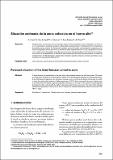Por favor, use este identificador para citar o enlazar a este item:
http://hdl.handle.net/10261/45648COMPARTIR / EXPORTAR:
 SHARE SHARE
 CORE
BASE CORE
BASE
|
|
| Visualizar otros formatos: MARC | Dublin Core | RDF | ORE | MODS | METS | DIDL | DATACITE | |

| Título: | Situación estimada de la zona cohesiva en el horno alto |
Otros títulos: | Forecast situation of the blast furnace cohesive zone | Autor: | Cores Sánchez, A. CSIC; Saiz de Ayala, J.; Mochón Muñoz, J. CSIC; Ruiz-Bustinza, I. CSIC ORCID; Parra, R. | Palabras clave: | Horno alto Zona de reserva Sinterización Red de sistema neuronal Blast furnace Cohesive zone Thermal reserve zone Sintering Neuronal network system |
Fecha de publicación: | 2010 | Editor: | CSIC - Centro Nacional de Investigaciones Metalúrgicas (CENIM) | Citación: | Revista de Metalurgia 46 (4) : 293-307 (2010) | Resumen: | [ES]En planta piloto se fabrica una serie de sinterizados a partir de mezclas minerales como las utilizadas en el horno alto.
Se caracterizan los sinterizados mediante análisis químico y granulométrico y determinación de las temperaturas
de reblandecimiento y fusión. En el horno alto, mediante una serie de sondas, se determinan las temperaturas en el
horno, lo que permite situar la posición de la isoterma de mayor temperatura de 950 °C, que corresponde a la zona de
reserva térmica. Se ha desarrollado un modelo que propone una estimación indirecta de la forma de la zona cohesiva
a través de la determinación de la isoterma de mayor temperatura de la zona de reserva térmica. Los valores de
las temperaturas de reblandecimiento y fusión de los sinterizados permiten estimar las isotermas que limitan la zona
cohesiva, en el intervalo de 1.300-1.400 °C. [EN] A series of sinters are manufactured in the pilot plant, using a mineral mixture, like that blast furnace. The sinters are characterised, by chemical and granulometric analysis and by determining the softening and melting temperatures. In the blast furnace temperatures are determined by using a series of probes in the furnace which make it possible to locate the position of the isotherm of higher temperature of 950°C, which correspond to the reserve thermic zone. A model has been developed, proposing and indirect estimation of the shape of the cohesive zone through the determination of the isotherm with the highest temperature in the thermic reserve zone. The values of the softening and melting temperatures of sinters can be used to estimate the isotherms limiting the cohesive zone in the 1300- 1400 °C range. |
Versión del editor: | http://revistademetalurgia.revistas.csic.es/index.php/revistademetalurgia/article/view/985/996 | URI: | http://hdl.handle.net/10261/45648 | DOI: | 10.3989/revmetalm.0909 | ISSN: | 0034-8570 |
| Aparece en las colecciones: | (CENIM) Artículos |
Ficheros en este ítem:
| Fichero | Descripción | Tamaño | Formato | |
|---|---|---|---|---|
| 996.pdf | 687,78 kB | Adobe PDF |  Visualizar/Abrir |
CORE Recommender
SCOPUSTM
Citations
3
checked on 12-abr-2024
WEB OF SCIENCETM
Citations
3
checked on 25-feb-2024
Page view(s)
270
checked on 22-abr-2024
Download(s)
521
checked on 22-abr-2024
Google ScholarTM
Check
Altmetric
Altmetric
NOTA: Los ítems de Digital.CSIC están protegidos por copyright, con todos los derechos reservados, a menos que se indique lo contrario.
